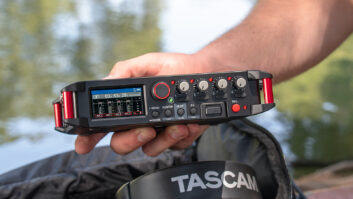(click thumbnail)Feature-laden mixers for broadcast and production need not be the size of a mechanic’s creeper anymore; Greg Mackie proved that to the pro audio world a few years back with the now-classic model 1202 mixer.
More recently, the low-power FM movement has accelerated demand for affordable, small, high-performance broadcast equipment.
Welcome to the age of the itty-bitty radio console, where diminutive mixers such as the Autogram Mini-Mix 8A and the LPB Communications Blue 5C add important broadcast attributes and functions to the basic mini audio mixer.
Harris Corp. recently tossed a new competitor into the fray: the ProCast audio mixing console, a medium-duty mixer with broadcast features and functionality, all in an 18-inch-wide chassis that can be rackmounted if desired.
The obvious customers for this mixer include broadcast operations outfitting multiple studios on a budget, LPFM operators and academic institutions with broadcast curricula.
Looking at the two
Product CapsuleThumbs Up:

- Styled as a traditional broadcast console
- 12 inputs, 6 outputs
- Multiple remote and monitoring capabilities
- Input level options easy to change
- Backed by Harris Corp.
Thumbs Down:
- Difficult to service faders
- Buttons do not feel durable
Price: $1,999
For information, contact Harris Corp. in Ohio at (800) 622-0022 or visit the Web site www.broadcast.harris.com.
Arguably the most visible competitor in the mini-board arena right now is the LPB Blue 5C, so it seems appropriate to draw comparisons with that model.
The ProCast was OEM’d by Henry Engineering, the MatchBox people, as the BC12 console and carries the Harris name. Its metal construction, linear faders, off-white surface finish and wooden side “wings” give the ProCast a more traditional broadcast-like appearance than the hip blue case of its LPB counterpart.
When scaled down to this size, however, the ProCast more resembles a small theatrical lighting board than a broadcast mixer.
There are 12 inputs – three mics and nine stereo line ins – with a 13th fader controlling the studio monitor level. Each fader handles a single input, vs. the A/B inputs of the LPB 5C.
The ProCast has six main bus outputs on XLR connectors. Both the Program and Audition mix bus outputs are stereo. In addition, there is a Mono output, which can provide a mono mix of the Program or Audition output.
The microphone preamps are clean-running SSM2017 chips, and the back panel includes insert jacks on each mic input for patching in EQs or limiters. Nice touch.
The manual accompanying the ProCast suggests the use of dynamic or ribbon microphones rather than powered condenser jobs. Curious wording, as I have not worked a ribbon mic at a station since 1988 and I wonder who does at this point.
Microphone inputs have trimmer pots to set optimum preamp gain, while line inputs have sensitivity switches to handle pro or consumer levels. Both are tucked inside the rear panel, out of the way of prying jock fingertips.
The LED ladder VU meter runs horizontally. While I prefer a Mackie-ish LED meter that runs vertically (and there appears to be room on the chassis for it), jocks are accustomed to seeing a meter that swings left to right. Points to Henry and Harris for thinking like a jock.
A tip of the hat also for the DB15 connector on the rear panel for remote mic control (on/off, cough and talkback), LED mic status lights and a Mute Tally output line. Your newsperson can remotely activate his or her mic from their booth or turret. A clear wiring diagram and remote control pinout is included in the manual.
A separate “booth feed” provides a headphone mix (with IFB) to your news talent. The console operator can switch the Booth feed so it either “follows” the Monitor system, or is dedicated to the Audition bus.
I should note the LPB Blue 5C also has two headphone jacks, each individually adjustable and able to independently monitor program or cue busses. But the 5C was laid out with the assumption that two announcers would be in the same space. The ProCast designers included a duplex talkback system, assuming studio-to-studio communication might be necessary.
Pull the panel
The ProCast innards contain a mix of discrete and surface-mount components and socketed ICs. Two circuit boards – one supporting the faders and one handling I/O – are joined by ribbon connectors.
An external power supply drives the ProCast. Do not expect to power the mixer with a plain vanilla wallwart should the main power unit fail.
The ProCast isn’t a modular console, but can be serviced in the field, albeit with some effort.
Unscrewing the bottom plate provides access to the SSM2017 and 5532 chips. The components most commonly prone to failure and replacement – rotary pots, switches and faders – are obscured by the PC board.
Henry Engineering notes that gaining access to the faders takes no more than 15 minutes, but still requires disassembly of the ProCast. It is doable, but I wish there were a simpler repair method. And in all fairness, the LPB Blue 5C is equally resistant to field repair.
An unfortunate reality about small mixers today – broadcast or otherwise – is that they are difficult to service by the end user. Such is the tradeoff with most inexpensive electronics today – the advantage of fast assembly sometimes sacrifices easy serviceability.
Music store-grade “hip-hop” turntable mixers have field-replaceable faders built to be swapped out in case of failure. It seems odd that semi-pro disco units and not the ProCast should be the ones designed for this.
Fortunately, swapping over to an unused input on the ProCast is easy, should a fader fail. Just pull the quarter-inch plugs and move them over to an unused input.
And to Henry’s credit, the ProCast is shipped with an emergency spare parts kit which includes a replacement fader, a rotary pot and a few pushbutton switches.
Harris squeezed telephone capabilities into the ProCast, adding a mix-minus bus and accompanying XLR Send plug to the back panel. Any input set for Program becomes part of the mix-minus feed except for Line Channel No. 4, which is the dedicated phone hybrid input.
While simplifying how a caller gets on the air live, the hard-wired bus does not allow off-air recording of a phone caller via Audition while another event is playing – program material also gets recorded. A Utility bus would have come to the rescue here.
A clever cluster of buttons allows a number of monitoring and meter options, including monitor dimming, off-air monitoring via an external receiver and a Cue/Program blend called “QMIX,” allowing cue channel monitoring through the Right Program speaker instead of the typically tiny cue speaker.
The Prog/Aud/Cue pushbuttons and the mic keys concern me as feeling lightweight and perhaps not up to the rigors of long-term switching. But except for the mics, the tendency is to simply turn down a particular fader to kill that channel, rather than strike buttons.
There is a row of momentary contact SPST buttons beneath the stereo faders, meant for remote activation of external equipment. These differ from the Blue 5C, which provides constant closure as long as a channel switch is active.
The clever engineer can construct a black box that offers latching or momentary closures, or simply purchase a Henry Engineering LogiConverter to accomplish this.
Audio specs are typical for a small mixer. Frequency response levels off at 15 kHz, which is fine for a small FM operation and absolutely stellar for an AM operation. Some may snort at a cutoff below 20 kHz, but nobody will ever hear that extra 5 kHz over the air.
Other published specs indicate crosstalk at 65 dB at 1 kHz, and 0.02 percent total harmonic distortion and intermod at nominal output level.
Keep a couple of SSM2017 chips handy in your parts inventory. According to the Analog Devices Web site, the IC manufacturer considers the component obsolete and recommends the newer AMP 02 as a replacement. Another alternative is the 1510 IC, an improved version of the SSM2017, from That Corp.
Finally, some legends persist forever, but I don’t know about the legends screened onto the control surface. As I have observed before, some expensive consoles can lose their paint job from normal use in very short periods.
As I only had the ProCast for less than a month, it was not possible to check the screening for durability. A nice Lexan coating over the top surface as a precaution might add to the longevity of the mixer.
Thoughts
There will always be compromises when going the small-mixer route. Make sure the features of one console over another are the ones you need and that you can live within the limitations therein.
Right now, the ProCast has the advantage being more “serious” than the Blue 5C does, and it offers numerous monitoring and remote options that puts it on par with bigger boards. The drawbacks are its serviceability and moderate-duty pushbuttons.
But at $1,999, I suppose it is possible to afford two mixers and keep one in the crate as a backup unit while the other is off being worked on.
LPB Communications is poised to release a line of add-ons for its Blue 5C mixer, including a relay interface for momentary or sustained closures, and a multiple input switcher to enhance the mixer’s versatility.
If Harris follows suit and similarly supports the ProCast with add-ons suggested by users, it will be a contender.







